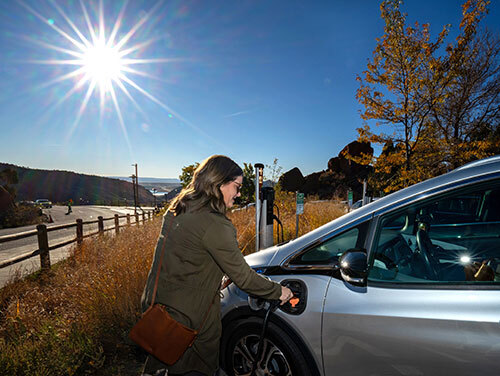
Electric vehicles (EVs) offer numerous advantages, including improved fuel economy, reduced fuel costs, and lower emissions. By using electricity as a power source, EVs contribute to better public health, a cleaner environment, enhanced safety, and a more resilient transportation system.
The transportation sector is the largest source of greenhouse gas emissions in the United States. Transitioning to cleaner transportation requires a variety of vehicle and fuel solutions, with a focus on life cycle emissions. Electric and hybrid vehicles provide significant emissions benefits compared to conventional vehicles. All-electric vehicles produce zero tailpipe emissions, while plug-in hybrid electric vehicles (PHEVs) emit no tailpipe emissions when operating in electric mode. Hybrid electric vehicles (HEVs) also offer emissions benefits, though these vary by model and hybrid system type.
The life cycle emissions of an electric vehicle depend on the electricity source used for charging, which differs by region. In areas with cleaner energy production, EVs typically have a life cycle emissions advantage over gasoline or diesel vehicles. However, in regions reliant on conventional electricity generation, the emissions benefits may be less pronounced. Use the
to compare life cycle emissions of specific vehicle models in your area.
EVs are equipped with advanced batteries designed for long life, though they will eventually wear out. Many manufacturers offer 8-year/100,000-mile battery warranties. According to predictive modeling by the National Renewable Energy Laboratory, current batteries may last 12 to 15 years in moderate climates and 8 to 12 years in extreme climates. Factors such as driving habits, charging patterns, battery chemistry, and thermal management also influence battery life.
Check with your dealer for model-specific battery life and warranty details. While replacement battery costs are not typically published, some manufacturers offer extended warranty programs for a monthly fee. Replacement costs outside the warranty period can be significant, but battery prices are expected to decline as technology advances and production scales up.
While EVs generally have lower energy costs than conventional vehicles, their upfront purchase prices can be higher. However, these costs are likely to decrease as production volumes grow and battery technology matures. Initial expenses can also be offset by fuel savings, federal tax credits, and state or utility incentives. The federal Clean Vehicle Tax Credits are available to consumers, businesses, fleets, and tax-exempt entities for new, used, and commercial clean vehicles, including all-electric vehicles, PHEVs, fuel cell EVs, and EV charging infrastructure. Additional state and utility incentives can be found in the Laws and Incentives database. For more information, contact your local Clean Cities and Communities coalition.
Use the Vehicle Cost Calculator to compare the lifetime ownership costs of electric and conventional vehicles.
Fuel Economy
EVs can significantly reduce fuel costs due to the high efficiency of electric-drive components. All-electric vehicles and PHEVs measure fuel economy differently than conventional vehicles, using metrics like miles per gallon of gasoline equivalent (MPGe) and kilowatt-hours (kWh) per 100 miles. Modern all-electric vehicles and PHEVs in electric mode can achieve over 130 MPGe and travel 100 miles using only 25–40 kWh.
HEVs typically offer better fuel economy and lower fuel costs than their conventional counterparts. For example, the 2024 Toyota Corolla Hybrid has an EPA-estimated combined fuel economy of 50 MPG, compared to 35 MPG for the conventional 2024 Corolla. Use the Find A Car tool on FuelEconomy.gov to compare fuel economy ratings of hybrid and conventional models.
For medium- and heavy-duty EVs and PHEVs, fuel economy depends on load and duty cycle. However, in suitable applications, all-electric vehicles maintain a strong cost advantage over conventional vehicles.
Infrastructure Availability
All-electric vehicles and PHEVs benefit from flexible charging options, as the electric grid is accessible in most parking locations. Charging requires an EV charging station, also known as electric vehicle supply equipment (EVSE). Drivers can charge at home (including multifamily housing), workplaces, or public charging stations. PHEVs offer added flexibility by allowing refueling with gasoline or diesel when needed.
While public charging stations are not as widespread as gas stations, efforts by automakers, utilities, governments, and organizations are rapidly expanding the national charging network. As of 2024, the U.S. has over 60,000 public charging stations with more than 162,000 charging ports, according to the Alternative Fueling Station Locator. Search for charging stations near you.
Energy Security and Resilience
The transportation sector accounts for about 30% of total U.S. energy needs and 70% of petroleum consumption. Increasing the use of energy-efficient vehicles like hybrids and EVs supports the U.S. economy and diversifies the transportation fleet. The diverse energy sources used for electricity generation enhance energy security for the electrified transportation sector, making it more resilient to natural disasters and fuel supply disruptions.
HEVs use less fuel than conventional vehicles due to regenerative braking, which recaptures energy lost during braking. PHEVs and all-electric vehicles (battery electric vehicles or BEVs) can operate solely on electricity, which is produced domestically from sources like natural gas, coal, nuclear energy, wind, hydropower, and solar energy. This reduces reliance on imported fuels and strengthens national energy security.
By adopting electric vehicles, consumers can enjoy lower operating costs, reduced emissions, and contribute to a more sustainable and secure energy future.